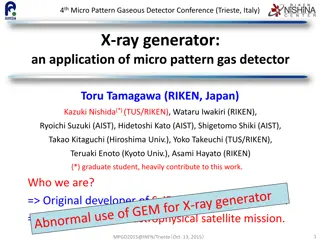Exploring Super-giant Fast X-ray Transients with Suzaku Studies
Suzaku studies Super-giant Fast X-ray Transients (SFXTs), a unique class of High Mass X-ray Binary systems exhibiting drastic flares with significant flux increases over short timescales. This research delves into the absorption, continuum, and iron lines of SFXTs using wide-band spectroscopy provided by the Suzaku satellite. Observations of specific SFXTs like IGR J17544-2619 and AX J161929-4945 reveal intriguing behaviors during flares, shedding light on their complex nature. Detailed reanalysis focusing on iron lines enhances our understanding of these phenomena. Suzaku's power in studying SFXTs showcases its importance in unraveling the mysteries of these high-energy astrophysical objects.
Download Presentation

Please find below an Image/Link to download the presentation.
The content on the website is provided AS IS for your information and personal use only. It may not be sold, licensed, or shared on other websites without obtaining consent from the author. Download presentation by click this link. If you encounter any issues during the download, it is possible that the publisher has removed the file from their server.
E N D
Presentation Transcript
Suzaku studies of SFXTs The University of Tokyo M.Sasano K.Nakajima, S.Yamada, T. Yuasa, K.Nakazawa, K. Makishima The X-ray Universe 2011
1. Introduction ~Power of Suzaku in SFXT studies~ SFXTs (Super-giant Fast X-ray Transients), a new class of High Mass X-ray Binary, show - Very drastic flares on short time scales ( a few hours), with flux increases by 2-3 orders of magnitude. Sometimes very slow pulsations. Highly absorbed hard spectra. - - - Wide-band spectroscopy is essential in their studies. Using Suzaku, we can study - - Absorption - Continuum - Iron lines 1A1118-61 Suchy et al. (2011) The X-ray Universe 2011
2. SFXTs observed with Suzaku So far, Suzaku observed 6 SFXTs, and will observe 2 more. Data sets of 5 objects are publicly available. Two of the 5 objects exhibited flares typical of SFXTs. IGR J17544-2619 Rampy et al. (2009) counts/s/keV count/s 200 100 Time (hr) 00 1 40 40 Energy keV 20 60 The absorption fluctuated in the flare. Fe-K EW < 14.2 eV (quiescence),< ** eV (flare). AX J161929-4945 Morris et al.(2009) A high absorption ( 1023cm-2), with some changes in a flare. Fe-K EW < 300 eV (quiescence) ,< 50 eV (flare). We perform detailed reanalysis of AX J161929-4945 focusing on the iron line. The X-ray Universe 2011
3 .Light curves of AX J161929-4945 1.5 count/sec 1.0 0.5 count/sec 1.0 0.5 5 Hardness 1 20 60 0 40 Time (ks) The X-ray Universe 2011
3 .Light curves of AX J161929-4945 1.5 count/sec 1.0 0.5 A large flare was detected. count/sec 1.0 0.5 5 Hardness 1 20 60 0 40 Time (ks) The X-ray Universe 2011
3 .Light curves of AX J161929-4945 1.5 count/sec 1.0 0.5 count/sec 1.0 30 times 0.5 5 Hardness 1 20 60 0 40 Time (ks) The X-ray Universe 2011
3 .Light curves of AX J161929-4945 1.5 count/sec 1.0 0.5 count/sec 1.0 0.5 Duration 4 hr 5 Hardness 1 20 60 0 40 Time (ks) The X-ray Universe 2011
3 .Light curves of AX J161929-4945 1.5 count/sec 1.0 0.5 count/sec 1.0 Rise time 1.4 hr 0.5 5 Hardness 1 20 60 0 40 Time (ks) The X-ray Universe 2011
3 .Light curves of AX J161929-4945 1.5 Flare count/sec 1.0 Quiescence 0.5 count/sec 1.0 0.5 5 Hardness 1 20 60 0 40 Time (ks) The X-ray Universe 2011
4. Spectral analysis 4-1 Background-subtracted count spectra Flare Quiescence XIS HXD The X-ray Universe 2011
4-2. Ratio between flare and quiescence 10 Ratio 1 10 1.5 40 Energy (keV) The X-ray Universe 2011
4-2. Ratio between flare and quiescence 10 Ratio From 1.5 keV to 40 keV Spectral shape did not change. Average NHremained nearly the same. 1 10 1.5 40 Energy (keV) The X-ray Universe 2011
4-3. Focus on Iron line Flare Quiescence Energy (keV) 7.5 5.5 The X-ray Universe 2011
4-3. Focus on Iron line Flare Quiescence The narrow iron line was detected in quiescence. Energy (keV) 7.5 5.5 The X-ray Universe 2011
4-3. Focus on Iron line Flare However, in the flare, the narrow line almost disappeared. A broad one may be allowed. Quiescence The narrow iron line was detected in quiescence. Energy (keV) 7.5 5.5 The X-ray Universe 2011
4-4. Model fitting Model wabs (cutoffpl+Gaussian) 1 0.1 count/s/keV 0.01 1e-3 1e-4 2 0 -2 1 Energy(keV) 10 The X-ray Universe 2011
4-4. Model fitting Model wabs (cutoffpl+Gaussian) NH(1022cm-2) +0.7 8.4-0.6 +0.5 -0.7 7.8 1 Photon index 0.82+0.17 -0.16 0.1 0.85+0.23 -0.19 count/s/keV 0.01 Ec(keV) Ecut(keV) 19 3.1 23 5.5 1e-3 6.39 0.2 6.39 0.03 1e-4 2 0 -2 0.95(535) 0.97(529) 1 Energy(keV) 10 The X-ray Universe 2011
4-5. Iron line EW and width 68% and 90% confidence contour map EW eV Quiescence The line is narrow and highly significant. EW is consistent with the UL by Morris et al. 77 Flare 44 A narrow lron line cannot have EW > 50 eV. Consistent with Morris et al. A broad one is allowed to have a consistent EW with the quiescent spectrum. 0.5 0.14 Width of iron line (keV) 0 The X-ray Universe 2011
5. Discussion Our results The absorption was same within 15% between flare and quiescence. In the flare, the iron line decreased in EW, or broadened. Assuming clumpy wind model (in t Zand 2005) The absorption should become higher in flares. Equivalent width of iron line should also increase. A simple clumpy wind model cannot explain our results. Assuming gated accretion model(Grebenev&Sunyaev2007,Bozzo+08) In quiescence, matters stored at Alfven radius can emit narrow Fe line. In flares, the matters fall onto the neutron star line broadening. The gated accretion model is favored by our result. The X-ray Universe 2011
6. Summary We reanalyzed Suzaku data of AX J161929-4945 which was studied by Morris et al. (2009). We compared spectra of the large flare with those of quiescence. The average NHremained same within 10%. In the flare, the iron line decreased in EW, or broadened. Our results prefer the gated accretion model to the clumpy wind model. The X-ray Universe 2011























